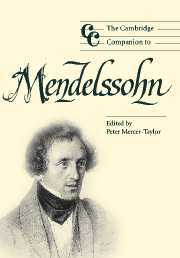Book contents
- Frontmatter
- Introduction: Mendelssohn as border-dweller
- Part I Issues in biography
- Part II Situating the compositions
- Part III Profiles of the music
- 6 Symphony and overture
- 7 The works for solo instrument(s) and orchestra
- 8 Mendelssohn's chamber music
- 9 The music for keyboard
- 10 On Mendelssohn's sacred music, real and imaginary
- 11 Mendelssohn's songs
- 12 Felix Mendelssohn's dramatic compositions: from Liederspiel to Lorelei
- Part IV Reception and performance
- Notes
- Select bibliography
- Index
11 - Mendelssohn's songs
from Part III - Profiles of the music
Published online by Cambridge University Press: 28 September 2011
- Frontmatter
- Introduction: Mendelssohn as border-dweller
- Part I Issues in biography
- Part II Situating the compositions
- Part III Profiles of the music
- 6 Symphony and overture
- 7 The works for solo instrument(s) and orchestra
- 8 Mendelssohn's chamber music
- 9 The music for keyboard
- 10 On Mendelssohn's sacred music, real and imaginary
- 11 Mendelssohn's songs
- 12 Felix Mendelssohn's dramatic compositions: from Liederspiel to Lorelei
- Part IV Reception and performance
- Notes
- Select bibliography
- Index
Summary
Mendelssohn began composing songs as a child – his setting of “Raste Krieger, Krieg ist aus” of 1820 anticipates Schubert's setting of the same text from Sir Walter Scott's The Lady of the Lake by five years – and continued to engage the genre throughout his life. One scholar has observed that in the span of twenty-eight years from 1819 to 1847, there was scarcely a single month in which he was not occupied with song composition. He published fifty-four songs with opus numbers (opp. 8, 9, 19[a], 34, 47, 57, and 71) and thirteen without opus numbers during his lifetime; after his death, thirty-one additional songs have been published, with approximately thirty-five either unpublished or available only in facsimile. But the 135 or so songs have often received less than their due, in part because many are apt for performance by amateurs, because they reflect salon culture in Vormärz Berlin, and because their composer does not probe Romantic subjectivity after the fashion of Schubert or Schumann. Reappraisal of Mendelssohn's lieder, however, reveals greater variety and depth than some have supposed. There are songs which make few concessions to an amateur musician's limitations, such as “Andres Maienlied” (Another May Song), op. 8, no. 8, or the “Reiselied” (Journeying Song), op. 34, no. 6; there are songs which acknowledge complex poetry in complex ways; there are poetic tastes to be accounted for and an aesthetic of song composition to be defined. This repertory holds riches still to be mined.
- Type
- Chapter
- Information
- The Cambridge Companion to Mendelssohn , pp. 189 - 205Publisher: Cambridge University PressPrint publication year: 2004



